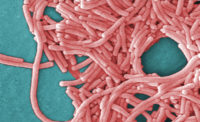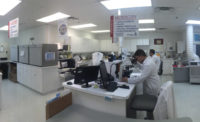
CLEVELAND, OH — Ford Motor Co. closed its Cleveland Casting Plant on March 14 due to a Legionnaires’ disease outbreak that has resulted in four confirmed cases and two deaths.
Officials originally reported that a cooling tower at the plant may have been the source of the legionella bacteria. Two subcontractors who became ill with what was believed to be pneumonia were working on the cooling tower. An employee who worked near the tower and was originally believed to have died of pneumonia was later confirmed to have Legionnaires’ disease.
Ford decided to voluntarily close the plant after the third case of the disease. The deceased worker who was rediagnosed with the disease became the fourth case and first fatality. A second worker died on March 16.
Up to 10 reported cases of pneumonia were also being given a second look.
Legionnaires’ disease is a type of pneumonia. Those who become ill inhale the bacteria, which are transmitted by water mists generated by such sources as cooling towers, shower heads, whirlpool spas, etc.
John McLeod, assistant director with the Division of Environmental Health, Cuyahoga County Board of Health, said that the cooling tower is just one of the possible sources of contamination in the plant. The investigative team “took over 150 water samples” throughout the plant, he noted. The team included officials from the Centers for Disease Control and Prevention (CDC) and the Occupational Safety and Health Administration (OSHA).
McLeod said that it would take five to 10 days to get results from the water samples.
Once all the samples were collected, Ford proceeded with disinfecting the plant, which is a major producer of engine parts for the company. The company brought in Clayton Group Services of Novi, MI, to direct the disinfection of all possible sources of contamination in the facility. Ford employees returned to work on March 19.
“Legionella is ubiquitous,” pointed out McLeod. It is found in many types of water systems. Dr. Richard Besser of the CDC, a Legionnaire’s disease specialist, said, “Legionella is fairly commonly found in water supplies.”
Dennis Shea, an expert with the Cooling Technology Institute (CTI), said that cooling tower systems are always checked when a legionella outbreak occurs along with any other potential sources. He noted that legionella bacteria comes from the soil and can infect any water system that takes in outside air. “The infection can come from wind-blown dust that gets into a water stream that has proper conditions for bacteria growth,” he said.
“Any cooling system that has dead legs, closed off equipment, or is not routinely treated for biological control” can be a source of legionella contamination, Shea added.
“Good prevention and maintenance practices certainly are important” in halting contamination, said McLeod. Shea noted that CTI offers a guideline for the control of legionella that was developed by professional engineers and scientists. CTI members also contributed to an American Society of Heating, Refrigerating and Air-Conditioning Engineers (ASHRAE) guideline. (See related article on this page.)
Those most at risk to get Legionnaires’ disease, said Dr. Besser, are older adults, smokers, and people with underlying lung disease and certain types of cancer, as well as those with compromised immue systems.
The CDC estimates that 8,000 to 18,000 people get Legionnaires’ disease in the U.S. each year. The estimated mortality rate ranges from 5% to 30%.
Sidebar: How to Minimize Legionella
The Cooling Technology Institute (CTI) has published a guideline, Best Practices for Control of Legionella, which provides details on Legionnaires’ disease, legionella bacteria, and methods for preventing contamination of cooling water systems.The paper describes the conditions that promote legionella growth and then explains monitoring and testing procedures. Routine treatment and routine on-line disinfection are covered, followed by a step-by-step procedure for emergency disinfection. Recordkeeping is then touched on.
In summary, the CTI says that to minimize the proliferation of legionella, its consensus recommendations are:
The complete paper is available at www.cti.org.
The American Society of Heating, Refrigerating and Air-Conditioning Engineers (ASHRAE) also offers a published guideline. The document, Guideline 12-2000, Minimizing the Risk of Legionellosis Associated With Building Water Systems, supplies environmental and operational information for the ongoing control of legionella. It is available at www.ashrae.org and www.baltimoreaircoil.com.
Publication date: 03/26/2001







